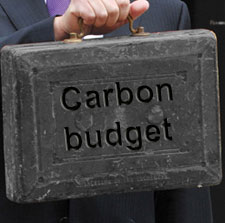Talking About Climate Change Targets: Temperature Rise vs PPM vs Carbon Budget
Targets are something we shoot at, or shoot for, or something we try to achieve. Climate targets are things we try to do so that climate change will have the least adverse impacts.
Some governments or institutions have set climate targets in terms of temperature increase: how much warmer over a pre-industrial period can the earth get before climate changes cause disastrous effects. Given uncertainties in our ability to understand and predict future climate conditions, the most common target is to aim for a temperature increase of not more than 2°C (3.6°F) above pre-industrial temperatures. The European Union and the UN climate talks, in Copenhagen in 2009, have adopted the target of keeping temperature rise at 2°C (3.6°F), although the hardness of the target is open to question. With recent climate conditions suggesting that the earth is warming faster than we expected, with even greater impacts that we anticipated, some argue that we must keep temperature rise below 2°C and closer to 1°C (1.8°F) to avoid calamitous impacts.
Some have set climate targets in terms of the maximum concentration of greenhouse gases (GHGs), or most often the concentration of the most prevalent and long-lasting GHG, carbon dioxide (CO2), that we can afford to have loaded into the atmosphere before climate change causes disastrous effects. If we are to have a 50% chance of avoiding the worst effects, we need to keep the concentration of CO2 at 450 parts per million (PPM) or lower. Again, some argue that recent studies suggest that to avoid those worst effects, we must keep the concentration at 350 ppm, or actually reduce the levels to 350 ppm since we have already reached a level of 400 ppm.
Some have set climate targets in terms of the amount of cumulative emissions of CO2, or sometimes CO2e [carbon dioxide equivalent, i.e., a measure of all GHGs converted to their equivalent in levels of CO2] that must not be exceeded over a set period if we are to avoid disastrous effects from climate changes. This is a measure more recently adopted in the conversation about climate change and is also referred to as a carbon budget. The recent 5th report by the IPCC, and other studies, have reported that we need to limit our total present and future emissions to a trillion tonnes of carbon (1000 GtC), or less, if we want to have a 50% chance of preventing a 2°C temperature rise. Since we have already emitted a total of half a trillion tonnes since the industrial revolution, we have a budget of only 500 million tonnes of carbon (GtC) left, and that will be used up by about 2050. A more recent study, by James Hansen and others, argues that we cannot afford 1 trillion tonnes but only 500 GtC total, that we have already emitted 370 GtC, and that we have a 100 GtC storage in the biosphere and soil. The study concludes that we have 130 GtC left in our budget if we are to avoid the worst effects, and that will be used up in several decades. See Sources below, and Report in this issue of irish environment on Hansen et al. study. After we reach our carbon budget, we have to suddenly and immediately stop spending fossil fuels, everywhere.
While all the ways of talking about targets are useful, the carbon budget offers a stark and probably more understandable target than temperatures and concentrations.
image: Canadian Awareness
First, the concept of a “budget” rests comfortably within easy reach of our day-to-day experiences, unlike much of the highly technical and scientific talk that surrounds climate change.
Second, measuring actual emissions already in the air offers a more direct connection with the problem we are trying to address as climate changes are driven by how much carbon we have loaded into the atmosphere.
Third, a carbon budget requires us to manage right now how much more carbon we can afford to emit, rather than have to imagine temperature and concentrations that will occur in 50 – 100 years. Since the currency of our budget is carbon, emitted by burning fossil fuel, one implication is that we have to look at how much money we have left and whether we can afford to spend it all. In other words, we have to decide now whether we can extract all the remaining global fossil fuel that is recoverable (we cannot).
We should always remember that most of this targeting is based on the premise that we accept a 50% chance of keeping temperature increases at 2°C. Wouldn’t it be comforting if we knew we had a better than 50% chance of avoiding disaster? If we can set ourselves a target to lose x pounds, or lower our cholesterol, to reduce our chance of a heart attack or stroke, it’s likely we’d pick numbers that would give us better than a 50% chance of suffering a heart attack or stroke. 100% is pretty tough but 75-90% would be much better than 50%.
Sources
Talking Climate: The gateway to research on climate change communication. talkingclimate.org/
Hansen J, Kharecha P, Sato M, Masson-Delmotte V, Ackerman F, et al. (2013) Assessing ‘‘Dangerous Climate Change’’: Required Reduction of Carbon Emissions to Protect Young People, Future Generations and Nature. PLoS ONE 8(12): e81648. doi:10.1371/journal.pone.0081648 [3 Dec 2013] www.plosone.org/article/info%3Adoi%2F10.1371%2Fjournal.pone.0081648 See Report in this issue of irish environment on Hansen et al. study.
David Adam, “Climate countdown: Half a trillion tonnes of carbon left to burn,” The Guardian (29 April 2009). www.theguardian.com/environment/2009/apr/29/fossil-fuels-trillion-tonnes-burned?guni=Article:in%20body%20link
Climate Change FAQ, “What’s the target for solving climate change?” The Guardian www.theguardian.com/environment/2011/nov/14/climate-change-targets?guni=Article:in%20body%20link
“Does talking about “carbon budgets” have somewhere to go, or nowhere?” ieBLOG irish environment (November 2013).



No comments yet, add your own below